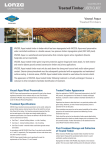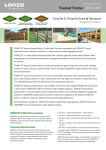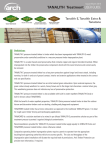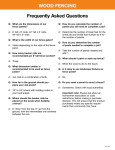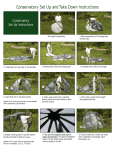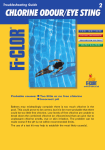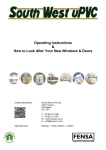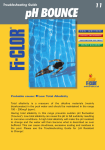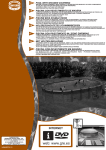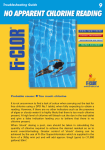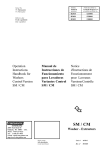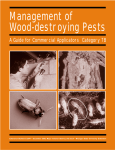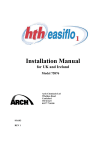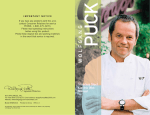Download Treated Timber USER GUIDE
Transcript
Issued February 2014 Treated Timber USER GUIDE Non-Com Exterior Treated Timbers Guidance for Use This document is designed to assist those using or specifying NON-COM Exterior treated materials. The document gives guidance prior to treatment and supplies information on ancillary properties and posttreatment use. NON-COM Exterior treatment is available from the Lonza Wood Protection dedicated fire retardant treatment facility at Castleford (UK). Description NON-COM Exterior fire retardant treated timbers have been impregnated with NON-COM Exterior fire retardant under controlled conditions in vacuum pressure timber impregnation plant. It is then kiln dried before being subjected to an elevated temperature curing process, converting water soluble chemicals to a permanently bonded water insoluble resin. NON-COM Exterior fire retardant is an advanced polymer based formulation, free from halogenated compounds. It is the only approved status type LR (Leach Resistant) treatment in the UK Wood Protection Association (WPA) Manual. Typical Applications Preparation of Timber for Treatment NON-COM Exterior treated materials are designed to be used in exterior or severe damp situations without the need for further protection. Typical applications include exterior cladding, exposed timbers and cedar shingles and shakes. This list is not totally exhaustive and gives an indication of the range of uses for NON-COM Exterior treated materials. The quality and appearance of the end-product is dependent on the quality and appearance of the substrate prior to processing. Timbers should be presented to the treatment centre in a dry and clean condition as follows: It is advisable to consult with Lonza Wood Protection using the contact details given in this document if in doubt about any particular area of application or compliance with relevant regional standards or specifications. • Large cross sectional timber must have a moisture content of 28% or less, and preferably to its end use moisture content. Before Treatment A wide range of timber based materials can be treated with NON-COM Exterior. Always obtain full details of where and how the timber will be used before treatment and then discuss your requirements with Lonza Wood Protection to confirm the relevant test data and European species specific fire (Euroclass) classification reports are available. The responsibility for determining that any product or building component complies with the relevant market specific Building Regulations, Standards or Codes of Practice rests solely with the client or specifier. Full assistance with specification writing is available on request from Lonza Wood Protection. • Timber boarding must be dried to a moisture content of 13-19%, and preferably to its end use moisture content. • All inner and outer bark must be removed from solid timber prior to treatment. • Material should be free from dirt, sawdust, surface coatings, surface water. • Timbers should not have received any previous preservative treatment. • Material should be free from all signs of attack by bacteria, blue staining fungi, wood destroying fungi or insect. • As far as possible, all ripping, profiling, notching, boring and extensive machining should be completed before treatment. See section on post-treatment machining. • Timbers must be adequately sheeted at all times during transport to and from the treatment plant and on-site. Treated Timber USER GUIDE Non-Com Exterior Treated Timbers • Packs must be adequately banded (not too tight) to avoid degradation during transport and handling and to allow good penetration during treatment. For maximum length and relevant pack size, please contact Lonza Wood Protection. • Supply a minimum 5% extra material with each order to allow for kiln degrade, kiln samples and moisture content samples. Some species will require more of a wastage factor than others. Consult Lonza Wood Protection for further advice. The final moisture content of NON-COM Exterior treated timber is in the region of 13-19%. This should be taken into account if supplying profiled components machined at moisture contents above this figure. For close tolerance work all timber must be machined at its equilibrium service moisture content. It is advisable to have representative samples treated prior to carrying out full scale treatments. The client can then be assured of the acceptability of the treated product. Treatment of Pre-Glued Assemblies In general, glued assemblies can be safely treated through the NON-COM Exterior process, provided suitable waterproof adhesives have been used. Always consult the adhesive manufacturer on the suitability and use of their particular product and follow the directions of the appropriate regional standards. The adhesive must be allowed time to gain sufficient strength to tolerate the effect of the vacuum pressure treatment. It is recommended that advice be sought before sending any material for treatment.and associations should be followed. Full details of the NON-COM Exterior treatment process are recorded for each charge. This ensures that the treatment conforms to the specification and that the correct treatment process and kiln drying schedule has been followed. A Treatment Certificate will be issued on request. Please note that the treatment process parameters are varied according to the timber species and end use of the treated material commodity, taking into account the required fire performance. Post Treatment Storage Before and after processing, the timbers and plywood must be protected from the weather during storage. Timbers cannot be re-profiled once treated. NON-COM Exterior processed material, being kiln dried, will reach the building site at a pre-specified moisture content and is ready for immediate installation. If the treated material is to be stored on-site prior to installation, this should be in a building with atmospheric conditions corresponding to its service environment. If storage in a building is not possible, the treated material must be stored out of ground contact and well protected from the ingress of moisture and dirt by a protective covering e.g. a tarpaulin or plastic sheeting, whilst allowing the treated material to breathe. NON-COM Exterior treated materials are valuable building products and should be stored with care at all times to avoid physical damage and surface disfiguration. Moisture Content Appearance Electrical moisture meters are not suitable for measuring the moisture content of Non-Com Exterior treated timber. The only reliable way to measure wood moisture accurately is by using an oven dry method. The appearance of timber is commonly not significantly affected by NONCOM Exterior treatment. However, under certain conditions, treatment may darken the wood slightly, dependent on species, but the basic tone and hue of the wood generally remains unchanged. As far as possible all cutting, machining, notching and boring is to be carried out prior to treatment. Post Treatment Machining For decorative solid timbers the use of less resinous timbers such as Western Red Cedar and Siberian Larch is recommended. With the use of Redwood (Pinus sylvestris) there is the possibility of natural resin exudation being accentuated by the heat curing process. To a lesser extent, resin exudation may occur with Douglas Fir. Fire classification applies to the final form of a material. The fire performance of any rip sawn, thicknessed, equalised, planed or extensively drilled material will be downgraded. The machined material must be returned to the treatment plant for re-treatment with NON-COM Exterior. The treatment process can occasionally generate splitting, cracking, cupping, or bowing of certain materials. Movements are dependent on species and commodities. Providing that the cut edges of the treated timbers are butt jointed, timbers can be sawn without affecting the fire retardant properties. Sticker marks can occur as a result of the treatment. When material is to be used decoratively, if specified and where possible, it will be dried with a sticker mark free face for an architectural finish. For pre-glued material, any weaknesses in the glue line may be exaggerated as a result of treatment. This is most noticeable where uneven glue is spread or pre-curing has occurred in manufacture. Confirmation of Treatment NON-COM Exterior treatments are carried out in accordance with the UK WPA Quality Scheme operating under ISO 9001 Quality and ISO 14001 Environmental standards. Post Treatment Gluing It is the end user’s responsibility to ensure compatibility of any adhesive to be used. When NON-COM Exterior treated material is to be bonded, always consult the adhesive manufacturer for suitable recommendations. In consultation with the adhesive manufacturer, select an adhesive appropriate to the in-service exposure conditions and the load bearing or non-load bearing requirements. The adhesive manufacturer should also inform you on the suitability and use of their particular product and give guidelines to follow the directions of the appropriate regional standards. Prior to bonding, a preparation of the material might be required. Always consult your adhesive manufacturer for appropriate recommendations on Treated Timber USER GUIDE Non-Com Exterior Treated Timbers surface preparation and specifications during bonding. The curing time and temperature during bonding might have to be increased. Surface Coatings Because NON-COM Exterior treated timber is specifically designed for external situations, a decorative finish is not required. However, when it is preferred, NON-COM Exterior treated materials have been successfully coated with clear, pigmented and opaque products. conditions including moisture content, temperature, atmospheric pollution, proximity to coastal locations, timber species, as well as the thickness of any galvanising. • Galvanising provides a sacrificial zinc barrier. It is important that the specifier is aware that there are many thicknesses of galvanised coating available and the thicker the galvanised coating the longer the expected service life. The level of galvanising should be commensurate with the end use. Lonza Wood Protection can offer DRYWOOD Woodstain, a waterbased, factory applied coating system to NON-COM Exterior treated materials that will provide a high performance decorative finish. For more information of DRYWOOD Woodstain please contact Lonza Wood Protection. • For exterior use, where the timber is likely to become wet and a long service life is required, greater corrosion resistance will be achieved with use of stainless steel in preference to other types of fittings. If users wish to use other coating systems it is the users responsibility to ensure compatibility of any coating to be used. When NON-COM Exterior treated material is to be coated, always consult the coating manufacturer for suitable recommendations, confirmation of adhesion and long term durability characteristics and the impact on the fire performance of the treated timber. Coated surfaces will require maintenance in accordance with the manufacturer’s instructions. • Due to a high level of tannic acid, species such as western red cedar or oak can cause corrosion to unprotected metals. For these species, it is therefore recommended to use galvanised or stainless steel. It is important to confirm the final finish does not downgrade fire performance, achieved by the NON-COM Exterior treatment. Highly flammable finishes such as nitro-cellulose based lacquers must not be used. When painting or staining, as with untreated timber, the surface should be clean and dry throughout the surface. A light sanding and thorough wiping with a damp cloth, or power washing should be performed prior to the application of any finish to provide a clean surface and to smooth any raised grain to optimise adhesion. In the case of rough sawn timber or textured plywood, brush the surface prior to staining. As with untreated wood, excessive surface moisture can cause finishing problems. The timber surface should be dried to an appropriate moisture content prior to finishing. If coating is to be undertaken on site, it is important to take appropriate precautions to protect the treated product from exposure to rain or extreme dampness. The paint or stain manufacturer’s recommendations should be followed taking note of the recommended maximum moisture content. The recommendations on sound painting practices, which are detailed in local standards and Codes of Practice (eg. BS6150 - Code of Practice for the Painting of Buildings – UK), should be followed. Always consult your coating manufacturer before applying a coating product to NON-COM Exterior treated material. Metal Fixings and Fittings Tests data show that corrosion of most metals in contact with NON-COM Exterior treated materials is no greater than with untreated timber. It is important to follow the recommendations of the manufacturer of any metal products used for specific advice regarding suitability, desired service life expectations and particular exposure conditions. Hot-dipped galvanised or stainless steel fixings and fasteners are recommended. NON-COM Exterior treated timber has a long life expectancy and it is appropriate to use metal fixings and fastenings that will have a comparable length of life. • Performance of metal fixings is influenced by the environmental • Electroplated metals only provide a thin coating and are unsuitable for exterior applications. • To prevent bimetallic corrosion between fastener/connector components it is important not to mix metals in the same connection. DO NOT mix galvanised and stainless steel components. • Attach connectors/fasteners/fittings after treatment and when moisture content is less than 20%. • Fixings and fastenings used on safety critical and load bearing components should be inspected regularly and replaced if necessary. • It is good practice to drill pilot holes for fixings, in particular when screwing near the edge or end of a piece of timber. Durability of Fire Performance The heat curing process involved in the NON-COM Exterior treatment polymerises the organic resins to form insoluble polymer molecules, locked inside the timber cells. The leach resistance of NON-COM Exterior within the treated timber ensures the durability of the fire performance in exterior exposure and severe damp situations. It is the only Approved status type LR (leach resistant) treatment in the UK Wood Protection Association (WPA) Manual. Desired Life Service NON-COM Exterior functions primarily as a flame retardant and does not contain wood preservative chemicals. However NON-COM Exterior fire retardant treatment offers a 30 year desired service life to timber in Use Class 3 situations (as defined by EN335 2013). Handling Precautions NON-COM Exterior treated timber and sheet materials are valuable building products and should be handled with care at all times to avoid physical damage and surface disfigurement. There are no additional safety requirements necessary for the handling of NON-COM Exterior treated timber and sheet materials over and above those for handling them in an untreated condition. Dust masks and eye protection are recommended to avoid possible irritation from dust or chips when carrying out permissible cross cutting, notching or boring after treatment. Gloves should be worn to protect the skin against abrasions and splinters. Avoid frequent or prolonged inhalation of sawdust. Consult local standards and Codes of Practice (eg. HSE Guide EH40, available on the Treated Timber USER GUIDE Non-Com Exterior Treated Timbers HSE website www.hse.gov.uk) for further information on workplace exposure limits for wood dust. These same precautions equally apply to untreated timber. Personal Hygiene After handling or working with NON-COM Exterior treated timber, all exposed skin should be washed before commencing other activities, especially eating, drinking, smoking or going to the toilet. If sawdust accumulates on clothes, clean them before reuse. Launder soiled clothes separately from other household wash items. Cuts and abrasions should, in any event, be protected by a water proof dressing and personal hygiene should predominate as a matter of routine. End Use Considerations NON-COM Exterior pressure treated material is treated to meet the requirements of a particular end use. This end use suitability should be confirmed by the supplier of the treated timber. It is best practice to prepare the timber as fully as possible prior to treatment to ensure best results. As far as possible all cutting, machining, notching and boring is to be carried out prior to treatment. Fire classification applies to the final form of a material. The fire performance of any rip sawn, thicknessed, equalised, planed or extensively drilled material will be downgraded. The machined material must be returned to the treatment plant for retreatment with NON-COM Exterior. It is the end users responsibility to ensure compatibility of any adhesive to be used. When NON-COM Exterior treated material is to be bonded, always consult the adhesive manufacturer for suitable recommendations. suitable recommendations, and confirmation of adhesion and long term durability characteristics. Coated surfaces will require maintenance in accordance with manufacturer’s instructions. On-Site Precautions All sawdust and construction debris should be cleaned up and disposed of after construction as below. Waste Disposal NON-COM Exterior treated timber, off cuts and end of life timber are not classified as hazardous waste. Local market regulations should be referred to. NON-COM Exterior treated timber and post treatment processing wastes such as sawdust and offcuts, must not be used for animal litter or bedding or for fuel in barbecues, cooking stoves or grates. Generally, domestic end users should dispose of any waste treated timber, sawdust or ash through the ordinary waste collection service or at a local authority amenity/disposal site. Any waste timber, sawdust or redundant timber from commercial or industrial use (e.g. construction sites) should preferably be recycled by reuse, or disposed of to an authorised landfill or to a correctly controlled and approved waste incinerator Further Information For further information NON-COM Exterior treated timbers or end grain preservatives please contact Lonza Wood Protection using the contact details below. NON-COM Exterior treated materials are designed to be used in exterior or severe damp situations without the need for further protection. If any coating is to be used, it is the end users responsibility to ensure compatibility with the treated material. When NON-COM Exterior treated material is to be coated, always consult the coating manufacturer for Lonza Wood Protection has produced this document for information only. Whilst every attempt has been made to ensure the accuracy and reliability of the information contained in this document, Lonza Wood Protection gives no undertaking, warranty or promise that the information is correct and customers should take all reasonable precautions to ensure the use and application of NON-COM Exterior pressure treated timber and sheet materials, as the case may be, is fit for the customers or end users particular purpose. Lonza Wood Protection expressly disclaims and excludes all warranties, conditions, representations and terms, whether expressed or implied by statute, common law or otherwise with respect to the information contained in this document or the subject matter thereof. Lonza Wood Protection reserves the right, at its sole discretion, to amend or withdraw any information contained in this document but does not undertake any duty to update such information. This document does not form part of any contract between Lonza Wood Protection and its customers and is not intended to give rise to any rights or cause of action for the customer against Lonza Wood Protection. This document is for guidance only and the customer is advised to seek its own advice as to whether the products mentioned in the document are fit for the customer’s particular purpose and are safe to use, store and handle in the circumstances contemplated by the customer. This document does not negate any exclusions of liability of Lonza Wood Protection in the contract of sale for its products. This document has been written for businesses purchasing NON-COM Exterior service treatment for timber and sheet materials from Lonza Wood Protection. The customer is advised to read the document in full as it contains important information, but the customer needs to decide for itself whether or not the product is suitable for its or the end users particular purposes and should ensure that its employees, contractors and others working for it and who will use the products do so in a safe manner. This document is intended for use by businesses only and is not intended to be used by retail consumers. © Copyright 2014 Lonza Wood Protection. ™ NON-COM is a registered trademark of Arch Timber Protection, a Lonza company. Lonza Wood Protection is a business of Arch Timber Protection, a Lonza company. Disclaimer: Whilst every attempt has been made to ensure the accuracy and reliability of the information contained in this document, Lonza Wood Protection gives no undertaking to that effect and no responsibility can be accepted for reliance on this information. Lonza Wood Protection updates its literature as and when necessary. Please ensure you have an up to date copy. Wheldon Road, Castleford, West Yorkshire, WF10 2JT. Tel: +44 (0)1977 714000 Fax: +44 (0)1977 714001 email: [email protected] www.lonzawood.com




